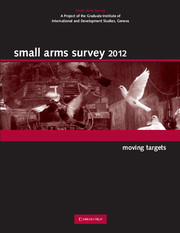Book contents
- Frontmatter
- Foreword
- Contents
- About the Small Arms Survey
- Notes to readers
- Acknowledgements
- Introduction
- Chapter 1 A Fatal Relationship: Guns and Deaths in Latin America and the Caribbean
- Chapter 2 When Business Gets Bloody: State Policy and Drug Violence
- Chapter 3 A Matter of Survival: Non-lethal Firearm Violence
- Chapter 4 Blue Skies and Dark Clouds: Kazakhstan and Small Arms
- Chapter 5 Between State and Non-state: Somaliland's Emerging Security Order
- Photo Essay. Troubled Waters: Somali Piracy
- Chapter 6 Escalation at Sea: Somali Piracy and Private Security Companies
- Chapter 7 Precedent in the Making: The UN Meeting of Governmental Experts
- Chapter 8 Piece by Piece: Authorized Transfers of Parts and Accessories
- Chapter 9 Point by Point: Trends in Transparency
- Chapter 10 Surveying the Battlefield: Illicit Arms in Afghanistan, Iraq, and Somalia
- Index
Introduction
Published online by Cambridge University Press: 05 February 2015
- Frontmatter
- Foreword
- Contents
- About the Small Arms Survey
- Notes to readers
- Acknowledgements
- Introduction
- Chapter 1 A Fatal Relationship: Guns and Deaths in Latin America and the Caribbean
- Chapter 2 When Business Gets Bloody: State Policy and Drug Violence
- Chapter 3 A Matter of Survival: Non-lethal Firearm Violence
- Chapter 4 Blue Skies and Dark Clouds: Kazakhstan and Small Arms
- Chapter 5 Between State and Non-state: Somaliland's Emerging Security Order
- Photo Essay. Troubled Waters: Somali Piracy
- Chapter 6 Escalation at Sea: Somali Piracy and Private Security Companies
- Chapter 7 Precedent in the Making: The UN Meeting of Governmental Experts
- Chapter 8 Piece by Piece: Authorized Transfers of Parts and Accessories
- Chapter 9 Point by Point: Trends in Transparency
- Chapter 10 Surveying the Battlefield: Illicit Arms in Afghanistan, Iraq, and Somalia
- Index
Summary
INTRODUCTION
In July 2001, UN member states met in New York to adopt the Programme of Action on Small Arms (PoA) and, more fundamentally, accelerate national, regional, and international efforts to tackle the small arms problem. The PoA focuses on arms control; it seeks to curb small arms proliferation by reinforcing controls over manufacture, international transfer, storage, and final disposal. A spin-off measure, the International Tracing Instrument, adopted in December 2005, is designed to strengthen weapons marking, record-keeping, and tracing. The UN small arms process also laid the groundwork for a parallel effort, centred on the Geneva Declaration on Armed Violence and Development (adopted in June 2006), aimed at enhancing our understanding of, and ability to respond to, the dynamics of armed violence.
Over the past decade, our knowledge of a range of small arms issues—including the scope of the arms trade and the negative impact of small arms in conflict and non-conflict settings—has grown considerably. But what of international efforts to combat small arms proliferation and armed violence?
In August–September 2012, UN member states will meet in New York for the PoA's Second Review Conference. States are asked to ‘review progress made’ in the PoA's implementation, but the reality is that the tools that would allow the UN membership to make such an assessment have yet to be developed. There is little doubt that the PoA and other similar measures, including many at the regional level, have spurred a wide range of activity, from improved marking practices to the destruction of surplus stocks. The Geneva Declaration's focus on measurability and programming has similarly catalysed a series of practical measures aimed at preventing and reducing armed violence.
- Type
- Chapter
- Information
- Small Arms Survey 2012Moving Targets, pp. 1 - 7Publisher: Cambridge University PressPrint publication year: 2012



